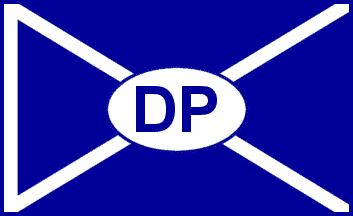 image by
Tracy Dunbar, 07 October 2001
image by
Tracy Dunbar, 07 October 2001
Last modified: 2019-01-01 by bruce berry
Keywords: seychelles | saltire | dp | seychelles national party | snp |
Links: FOTW homepage |
search |
disclaimer and copyright |
write us |
mirrors
See also:
 image by
Tracy Dunbar, 07 October 2001
image by
Tracy Dunbar, 07 October 2001
This is the flag of the Democratic Party of the Seychelles which governed the island state from
the first year of independence in1976 until 1977. It is now in opposition.
Source : Democratic
Party of the Seychelles home page
Gary Selikow, 06 October 2001
 image by Rob Raeside, 07 Sept 2016
image by Rob Raeside, 07 Sept 2016
Parti Lepep is actually the Seychellois Creole for the People's Party.
On 02 June 2009, the political party
which brought Seychelles to independence before transforming it into a modern,
middle-income country underwent a metamorphosis and changed its name from
SPUP-SPPF to Parti Lepep. This change of name encapsulates a sea-change
in the country’s politics. A new flag was also adopted which has a red field
with a sun and three sunbeams emanating from the canton.
Andreas Herzfeld, 07 Sept 2016
Party name history:
1964-1978 Seychelles People's United Party (SPUP)
1978-2009 Seychelles People's Progressive Front (SPPF)
2009-present People's Party
 image sent by Tomislav Todorovic, 07 Sept 2016
image sent by Tomislav Todorovic, 07 Sept 2016
The original flag of SPUP-SPPF, on which the design of the
national flag of the country used between 1977 and 1996 was based, is
partially visible in a 10 rupee stamp issued in 1989 to commemorate the 20th
anniversary of the founding of the party.
Tomislav Todorovic, 07 Sept 2016
![[Seychelles National Party]](../images/s/sc}snp.gif) image by Ivan Sache, 05 July 2008
image by Ivan Sache, 05 July 2008
The Seychelles National Party (SNP), a Liberal party, emerged as the clandestine "Parti Seselwa" in 1991; when multipartism was proclaimed the same year, the Party Seselwa was the first officially registered party. The next year, during which the first multiparty election scheduled in the country since 1974 took place, the Party Seselwa did not reach the 5% share of the votes and thus could not enter the Constituent Assembly that drafted the new Constitution. In the 1993 general elections, the Party Seselwa, the National Alliance Party and the Seychellois National Movement formed "The United Opposition" (UO). The UO won 9% of the share of the votes and the historic leader of the Party Seselwa, Wavel Ramkalawan, was proportionally-elected to the National Assembly.
In 1998, the UO increased its share of the votes to 27% and became the second
most represented party after the Seychelles Peoples Progressive Front (SPPF);
Ramkalawan was appointed leader of the opposition in the National Assembly. The
same year, the Party Seselwa was renamed the Seychelles National Party. In 2002,
the SNP increased its share of the votes to 43%, winning 11 of the 34 seats of
the National Assembly, which were confirmed in the 2007 election. Wavel
Ramkalawan could not manage to be elected President of the Republic, either in
2001 or 2006, with 44% and 46% of the share of the votes, respectively.
Source: SNP website.
Ivan Sache, 05 July 2008
![[Seychelles National Party]](../images/s/sc}snp-y.gif) image by Ivan Sache, 05 July 2008
image by Ivan Sache, 05 July 2008
The SNP website shows several photographs of meetings and street
demonstrations involving the party. The most frequently seen flag is a plain
green flag, with several shade variations. The party seat is located in a place
called Arpent Vert (literally "Green Arpent") which might be the origin of the
party's colour. During the "GST March" (2003), the green flag was used, together
with a green flag bearing the party acronym in yellow capital letters and
another green flag with an emblem.
Source:
http://www.snpseychelles.sc/picmarch.jpg.
Ivan Sache, 05 July 2008
![[Seychelles National Party]](../images/s/sc}snp-w.gif) image by Ivan Sache, 05 July 2008
image by Ivan Sache, 05 July 2008
During the 2006 campaign for
the presidential election, the green flag was again used, together with a
green flag bearing the party acronym in white capital letters.
Source:
http://www.snpseychelles.sc/picarrally.jpg
During the
"Candlelight March", 31 August 2007, another green flag was seen, charged
with unreadable writing in white letters.
Source:
http://www.snpseychelles.sc/pages/Candle%202.htm
Ivan Sache, 05 July 2008
![[Seychelles National Party]](../images/s/sc}snp-h.gif) image by Ivan Sache, 05 July 2008
image by Ivan Sache, 05 July 2008
During the "Rally
against High Cost of Living" (26 May 2008), green flags were still used,
together with green flags with the party's acronym either in yellow or white
capital letters. A green flag bears, below the party's acronym in yellow
capital letters, "Parti Seselwa" in white capital letters. An horizontally
divided green-white flag bears the party's acronym in green capital letters
in the white stripe.
Source:
http://www.snpseychelles.sc/Pictures/index.htm
Ivan Sache, 05 July 2008